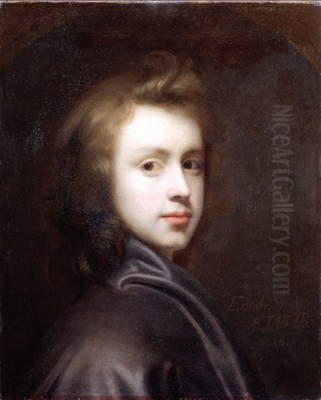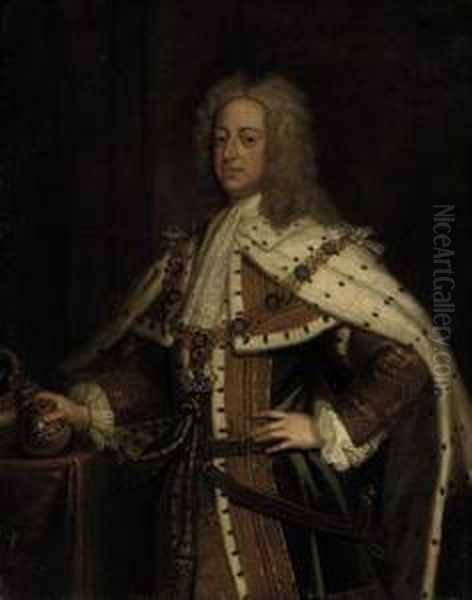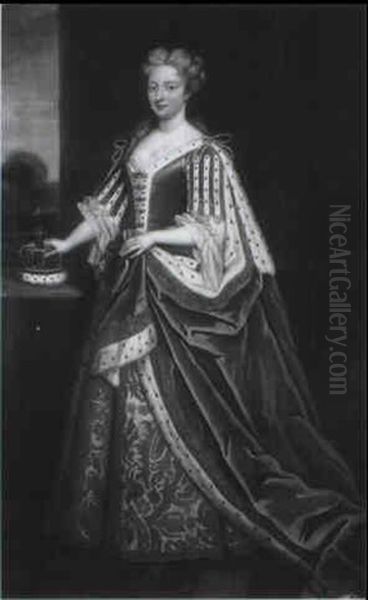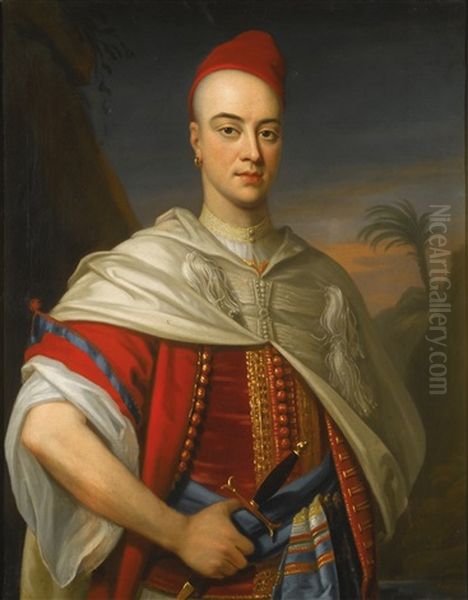
Enoch Seeman stands as a notable figure in the landscape of early Georgian portraiture in Britain. Active during the first half of the eighteenth century, he navigated an art world transitioning from the dominance of Sir Godfrey Kneller to the era that would eventually see the rise of figures like Reynolds and Gainsborough. Born into a family of artists and immigrating to London at a young age, Seeman carved out a successful career, securing patronage from the highest levels of society, including the Royal Family. His work, while perhaps not reaching the revolutionary heights of some contemporaries or successors, provides a valuable visual record of the Hanoverian elite, characterized by a solid technique and a keen eye for the details that signified status and identity in his time.
From Danzig to London: Early Life and Artistic Formation
Enoch Seeman the Younger, as he is sometimes known to distinguish him from his father, was born around 1694 in Danzig (modern-day Gdańsk, Poland). Danzig, a vibrant port city in Polish Prussia, had a rich artistic heritage, and Seeman was born into a milieu where painting was the family trade. His father, Enoch Seeman the Elder (also known as Isaac Seeman, though sources vary on the first name, Isaac is more commonly cited for the father), was himself a painter, primarily of portraits. It was under his father's initial guidance that the young Enoch likely received his first artistic training. The Seeman family appears to have been part of a network of artists operating in Northern Europe.
The pivotal moment in Enoch Seeman's early life came in 1704 when his father brought him from Flanders to London. London, at the dawn of the 18th century, was a rapidly growing metropolis and the political and economic heart of a burgeoning global power. It was becoming an increasingly important centre for the arts, attracting talent from across Britain and continental Europe. For an ambitious young painter like Seeman, London offered opportunities for patronage and advancement that were likely unavailable in his homeland or even in Flanders.

Remarkably, Seeman seems to have established himself quickly. An early group portrait of the Bisset family, reportedly painted in 1708 and now housed at Castle Grant, is sometimes attributed to him. If this date is accurate, it would mean Seeman produced a competent multi-figure composition at the remarkably young age of about fourteen. This suggests either a prodigious talent or perhaps collaboration with his father. Regardless, it indicates an early immersion in the professional practice of portrait painting shortly after his arrival in England.
Navigating the London Art World
The London art scene that Enoch Seeman entered was largely dominated by one towering figure: Sir Godfrey Kneller. Kneller, a German-born painter who had arrived in England decades earlier, had established an almost industrial-scale portrait practice, painting monarchs, aristocrats, intellectuals (the famous Kit-Cat Club portraits), and anyone of significance. His style, a competent and often formulaic late Baroque, set the standard for portraiture. Aspiring painters had to operate in his shadow, either emulating his style or seeking alternative approaches.
Other significant portraitists active during Seeman's early career included the Swedish-born Michael Dahl, Kneller's main rival, known for a slightly softer and more sensitive style. Charles Jervas, an Irish painter, was also prominent and would eventually succeed Kneller as Principal Painter to the King, though his reputation has perhaps suffered in comparison. Jonathan Richardson the Elder was another key figure, not only as a painter but also as an influential writer on art theory and connoisseurship. These artists, along with numerous lesser-known practitioners, catered to the immense demand for portraits in Georgian Britain, where likenesses served as crucial markers of lineage, status, wealth, and political affiliation.
Seeman found his place within this competitive environment. He seems to have absorbed the prevailing Knelleresque manner but gradually developed his own distinct characteristics. He benefited from the presence of other immigrant artists, demonstrating that London was a relatively open market for talent, regardless of origin. His family background and early training likely provided him with a solid technical foundation upon which to build his career.
Artistic Style: Between Baroque Formality and Rococo Detail
Enoch Seeman's artistic style is often characterized as transitional, occupying a space between the late Baroque conventions exemplified by Kneller and the emerging Rococo sensibilities that would become more prominent mid-century, particularly in the work of painters like Thomas Hudson (who would later teach Sir Joshua Reynolds). Seeman inherited some of the formality and emphasis on status found in Kneller's work, often employing standard poses and compositional formats. His figures are typically presented with a degree of gravitas appropriate to their station.

However, Seeman's work often displays a greater attention to the specifics of costume and texture than Kneller's more generalized approach. He excelled in rendering the sheen of silk, the richness of velvet, and the intricate patterns of lace. This focus on the material details of dress was not merely decorative; it served to underscore the sitter's wealth, fashionability, and social standing. Details like elegantly elongated fingers or the inclusion of specific props could further enhance the portrayal of refinement and cultural sophistication.
In terms of technique, Seeman's brushwork is generally competent and controlled, lacking the flamboyant bravura of some Baroque masters but achieving a solid and convincing representation. His use of color could be quite effective, employing contrasts and careful layering to create a sense of depth and volume, as noted in works like the portrait sometimes identified as Two Children, where the richness of the fabrics is a key element. While perhaps not consistently achieving deep psychological insight, his portraits generally offer good likenesses, fulfilling the primary requirement of the genre for his patrons.
Compared to his contemporaries, Seeman's style was perhaps less fluid than Jervas's at its best, less psychologically penetrating than Richardson's, and certainly lacked the narrative complexity and satirical edge of William Hogarth, who was forging a unique path in British art during the same period. Yet, Seeman offered a reliable and fashionable service, producing portraits that were dignified, detailed, and flattering, meeting the expectations of his clientele.
Royal Commissions: Painting the Hanoverian Court
A significant mark of success for any portrait painter in 18th-century London was securing commissions from the Royal Family. Enoch Seeman achieved this distinction, painting members of the newly established Hanoverian dynasty. This patronage not only brought prestige but also potentially led to further commissions from courtiers and those wishing to demonstrate loyalty to the crown.
Seeman painted King George I, the first Hanoverian monarch. A notable full-length coronation portrait, dated around 1730, is held by the Honourable Society of the Middle Temple in London. This imposing image presents the King in his ceremonial robes, embodying the authority and legitimacy of the new royal line. Seeman's ability to handle the complex regalia and formal pose demonstrates his capability in executing state portraits.

He also painted George I's successor, King George II. A portrait dated 1732 is housed in the Royal Collection at Windsor Castle. Additionally, Seeman portrayed Queen Caroline, George II's intelligent and influential wife. Versions of her portrait are also found in the Royal Collection and at the Yale Center for British Art (though often associated with Yale University due to another famous Seeman portrait). These royal commissions firmly established Seeman as a painter of note, operating at the highest level of British society. While he may not have held an official title like Principal Painter (which went to Jervas after Kneller), his access to the royal family was a clear indicator of his standing.
Portraits of the Wider Elite: Aristocrats, Gentry, and Scholars
Beyond the Royal Family, Enoch Seeman enjoyed patronage from a wide circle of aristocrats, members of the gentry, and other prominent figures. His client list included influential families such as the Graftons, Pembrokes, and Rockinghams, indicating his acceptance within the upper echelons of society. These commissions were the bread and butter of his practice, and his surviving works offer a gallery of Hanoverian Britain's ruling class.
One of his most famous works is the portrait of Elihu Yale, painted in 1717. Yale, a former governor of Madras for the East India Company and a significant benefactor of the collegiate school that would become Yale University, is depicted as a wealthy and worldly figure. The portrait, now held at the Yale University Art Gallery, is often cited as a key work in Seeman's oeuvre, showcasing his ability to capture a strong likeness and convey the sitter's importance. The date of 1717 places it relatively early in his independent career, suggesting his talent was recognized quickly.
Another well-regarded portrait is that of Sir James Dashwood, painted in 1737 and now in the collection of the Metropolitan Museum of Art, New York. This work has been described as "unusually lively," suggesting that Seeman was capable of moving beyond mere formality to capture something of the sitter's personality when the opportunity arose. Dashwood, a wealthy landowner and politician, is presented with confidence and style.
Seeman also painted figures like Abraham Tucker (1739, National Portrait Gallery, London), a philosopher and country gentleman, depicted in thoughtful repose. His portrait of Jane Pratt Taylor (c. 1743, Virginia Museum of Fine Arts) connects his work to the British colonies in North America, as portraits were often commissioned by or sent to family members across the Atlantic.
He was also adept at group portraits, a more complex undertaking. His depiction of Letitia Sandys (née Tipping) with her two sons, now in the National Portrait Gallery, London, showcases his ability to handle multiple figures and suggest familial relationships. An even larger group portrait is that of Lady Cust and her nine children, an ambitious composition held by the National Trust at Belton House. These works demonstrate his versatility within the portrait genre.
Seeman in Context: Contemporaries and Legacy
Evaluating Enoch Seeman's place in British art history requires situating him amongst his contemporaries. He operated during a period of flux. Kneller's long dominance ended with his death in 1723, creating opportunities for others. Seeman, along with painters like Dahl, Jervas, and Richardson, filled this space. However, new talents were also emerging. The French painter Jean-Baptiste van Loo visited London in the 1730s and enjoyed enormous, albeit temporary, success with his fashionable French style.
Thomas Hudson was establishing himself as a leading portraitist, known for his solid, reliable likenesses and his well-organized studio (which would later train Reynolds). Allan Ramsay, a Scottish painter, brought a new level of elegance and sensitivity to portraiture, particularly in his depictions of women, becoming a favoured painter later in the century. And, of course, William Hogarth pursued his unique path, focusing on narrative series ("modern moral subjects") and conversation pieces, though he also painted powerful individual portraits that often challenged conventions.
Compared to these figures, Seeman is generally considered a competent and successful painter of the second rank. He maintained a consistent output and served an elite clientele, including the King, but he did not fundamentally change the direction of British portraiture like Hogarth or, later, Reynolds and Thomas Gainsborough. His style remained largely within the established conventions, albeit updated with a Rococo attention to detail. He seems to have been patronized by families like the Graftons and Pembrokes, but perhaps did not command the very highest prices or achieve the widespread fame of Kneller before him or Reynolds after him.
His influence can be seen in the continuation of a solid, representational portrait style. His work, particularly portraits like that of Jane Pratt Taylor, also forms part of the transatlantic artistic exchange, providing models and examples for colonial patrons and artists. His paintings are now held in major public collections, including the National Portrait Gallery and Tate Britain in London, the Royal Collection Trust, the Metropolitan Museum of Art in New York, the Yale University Art Gallery, the Yale Center for British Art, and various National Trust properties, ensuring his contribution to British art is preserved and accessible.
He worked primarily from his residence in St Martin's Lane, a London street that was becoming a hub for artists and artisans. It was here that he lived and worked until his death. Sources generally place his death in March 1745, bringing to a close a career that spanned four decades of significant change in British society and art.
Conclusion: A Mirror to Hanoverian England
Enoch Seeman was a significant figure in the London art world of the early to mid-eighteenth century. An immigrant who achieved success through skill and diligence, he became a favoured portraitist of the Hanoverian court and aristocracy. His work bridges the gap between the established Baroque formulas of Sir Godfrey Kneller and the burgeoning Rococo style, characterized by its detailed rendering of costume and its generally dignified presentation of sitters.
While perhaps lacking the innovative genius of Hogarth or the transformative impact of Reynolds, Seeman produced a substantial body of work that reliably captured the likenesses and aspirations of his era's elite. His portraits of George I, George II, Queen Caroline, Elihu Yale, Sir James Dashwood, and numerous others serve as important historical documents, reflecting the tastes, fashions, and social hierarchies of Georgian England. As a painter who navigated the competitive London art market successfully, securing royal patronage and leaving behind a legacy of works in major collections, Enoch Seeman remains a noteworthy artist whose career illuminates the practice and function of portraiture in the age of Walpole. His life, from Danzig to the heart of the British establishment, exemplifies the opportunities London offered to talented artists from across Europe during this formative period in British art history.